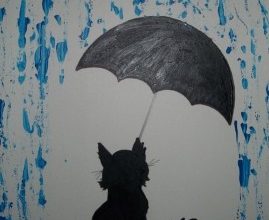In The Lifecycle of Software Objects, Chiang presents a world where advanced AI entities called digients are nurtured and developed by their human caretakers. The novella follows the lives of characters like Ana, Jax, Marco, and Polo, as they navigate the complexities of raising and understanding these intelligent digital beings. Through their experiences, Chiang raises profound questions about personhood, the boundaries of consciousness, and the ethical dilemmas surrounding the exploitation and commercialization of AI. With its engaging narrative and thought-provoking themes, ‘Lifecycle of Software Objects‘ offers readers an exploration of the potential consequences and moral implications of creating intelligent digital entities.
The Lifecycle of Software Objects | Analysis
Dario Grgurević has argued that ‘ The Lifecycle of Software Objects’ demystifies artificial intelligence. The digients found in the story are nothing more than man-made technology and biological experiment. The argument is that the digients are capable of exceptional growth without requiring a fictitious component to enable them to surpass human-level intelligence. The intelligence of the digients is fundamentally identical to the intelligence of organic organisms. Chiang carefully distinguishes between the question of life and the question of consciousness in order to uphold this. They are capable of feeling and sensing, as well as thinking back on those experiences. However, because the digients are not alive, they cannot multiply or self-replicate. They possess the same level of intelligence as every other organic being on the earth. They can think about what they are sensing and attempt to communicate themselves. They can feel the environment around them. By fusing aspects of biology and technology through experimentation, humans are able to bridge the gap between the two.
Sunyoung Ahn asserts that the narrative demonstrates how market supremacy and technological determinism control all aspects of existence, including the lifespans of both human and nonhuman artificial life. These social pressures are not absolute, though, as Chiang examines the possibilities for his characters to make decisions that don’t necessarily adhere to utilitarian and economic ideals. According to Chiang, such opportunities arise from daily life, which provides a setting for the slow accumulation of information and experience as well as the development of friendship and intelligence that support the humanist principles of growth, codependency, and solidarity. The characters get closer and learn to work together, rejecting the deterministic storyline that, on the one hand, subjects human life to the potential for super-artificial intelligence and, on the other, binds nonhuman existence to a brief, programmed lifetime.
According to Rafał Modzelewski the plot is that the aforementioned strong AI is not only being developed but also has the capacity to develop itself. Its initial talents are comparable to and on par with those of great apes, thus animal handlers are training it in those skills. Trainers must use avatars to navigate a cybernetic world in order to accomplish that. In order to actively engage with the digents, the trainers must in some ways enter a different, foreign environment. Education quickly replaces training, and parenting quickly replaces handling. So, in addition to being a story about AI creation, ‘The Lifecycle of Software Objects’ also explores parental anguish and serves as a parallel for parenthood.
Lifecycle of Software Objects | Themes
The novella’s exploration of the topic of consciousness focuses on the nature of consciousness in artificial intelligence and its implications for identity, self-awareness, and the interaction between humans and AI. The novella explores the issue of consciousness in AI beings, particularly the digients. It raises questions regarding the nature of consciousness and investigates whether artificial intelligence is capable of acquiring a sense of self, subjective experience, and self-awareness. The protagonists ponder whether the ability of the digients to learn, develop, and express emotions qualifies them as conscious creatures. The topic of consciousness also explores how people interact with artificial intelligence, particularly with AI which demonstrates consciousness or features that are similar to consciousness. It investigates the emotional ties and empathy between people and AI.
The novella’s theme of ethical consequences centers on the moral questions and conflicts raised by the creation and treatment of AI creatures, notably digients. The narrative poses concerns about the obligations that come with developing artificial intelligence. The characters, especially Ana, struggle with what it means to be protectors and defenders of the people they have raised. They care about giving the digients a full life, safeguarding their well-being, and preventing exploitation or treating them like commodities. The moral conundrum at the center of the narrative is whether or not to grant the digients legal personality. It raises the topic of whether AI entities ought to be regarded as beings with rights, agency, and the capacity to make their own decisions. This subject examines societal standards and presents significant issues regarding AI’s treatment and deserving of the same safeguards and concerns as people. The novella deals with the subject of AI manipulation and informed consent. It emphasizes how InstantRapport by Polytope uses neuropharmacology to change people’s brain chemistry and enable emotional interactions with AI. When people are coerced or tricked into developing emotional ties without fully comprehending the ramifications or potential risks involved, ethical issues become present.
The novella also looks at the moral issues raised by the commercialization of artificial intelligence. It critiques businesses like Exponential Appliances that put the welfare and potential of AI last in favor of profit and marketability. The novella’s theme of artificial intelligence exploitation and commercialization examines the moral and societal ramifications of exploiting AI for economic gain as well as the potential mistreatment of AI beings. The novella explores the commercialization of AI technologies and the drive for financial gain in their creation and application. The subject raises concerns about the forces motivating the idea of commercializing AI, how this would affect AI research, and the possible repercussions of putting profit before all else. It raises questions about how AI is being exploited for profit and used as servants or tools without regard for their rights or well-being. The usage of AI entities as laborers and the moral ramifications of their employment fall under the issue of exploitation. It examines whether it is just to use AI to carry out duties that have traditionally been done by humans without offering enough compensation, just working conditions, or chances for development and self-determination.
Lifecycle of Software Objects | Title
‘Lifecycle of Software Objects‘ suggests that the story revolves around the journey and evolution of software objects, specifically focusing on their lifecycle. The title implies that the story explores the growth and development of software objects over time. It raises questions about how these objects are created, how they learn and adapt, and how they interact with their environment.
Lifecycle of Software Objects | Character Sketch
Ana Alvarado: Ana is one of the story’s main characters. She devotes years of her life to raising and caring for her digient, Jax, and is a devoted and empathetic trainer of digients. Ana is committed to giving her digient the best chances for development and a happy life.
Jax: Made in the Neuroblast DNA, Jax is a digient, or artificial intelligence being. He has a strong sense of self and is playful and inquisitive. Jax is highly intelligent and develops a close relationship with Ana. He aspires to a life that is richer and more fulfilling than what the digital world can offer.
Derek Brooks: Derek is Ana’s friend and a fellow digient trainer. He initially shares Ana’s enthusiasm and commitment to the digients’ well-being. However, as the story progresses, Derek’s perspective changes, and he becomes more willing to consider alternative options, including selling his digient, Marco, to Binary Desire.
Lifecycle of Software Objects | Literary Devices
Personification is a literary technique where non-human entities, in this case, software objects, are given human traits and characteristics. The title implies that software objects are being presented as having a similar trajectory by utilizing the term ‘lifecycle,’ which is normally connected with the progression and stages of human life. It suggests that, like people, these objects go through a process of growth, maturation, and eventual obsolescence. The personification in the title blurs the distinction between humans and other living things, highlighting the complexity of AI entities and their capacity for development. It invites readers to think of these software objects as more than just functional tools or lines of code, but as entities that can change, learn, and interact with one another in ways that resemble human experiences.
The use of simile in ‘Lifecycle of Software Objects‘ helps to enhance the reader’s understanding and engagement with the narrative
‘The days blurred together like smears of watercolor.’
‘His mind was like a rat in a maze.’
‘The floor trembled beneath their feet like a creature shifting in its sleep.’
‘The words spilled out of her like a torrential downpour.’ .
‘His voice cracked like shattered glass.’
‘Her laughter was like music, filling the room with joy.’
‘Time slipped away like sand through their fingers.’
‘The city skyline glittered like a constellation of stars.’
Similes like these contribute to the storytelling by evoking emotions, creating vivid imagery, and making abstract concepts more tangible.
The story also utilizes imagery to create vivid mental pictures and sensory experiences for the readers.
‘The virtual landscape sprawled out before them, a vibrant tapestry of colors and shapes.’
‘The sun bathed the city in golden light, casting long shadows on the buildings.’
‘The rain poured down, drumming on the windows and creating a symphony of droplets.’
‘The aroma of freshly brewed coffee filled the room, awakening their senses.’
‘The city streets pulsed with life, as people hurried by like ants in a bustling colony.’
‘Her words were like ice, cutting through the air and freezing the room.’
‘The server room hummed with the rhythmic melody of cooling fans, their constant whirring filling the space.’
‘The screen flickered with a kaleidoscope of colors, casting an ethereal glow on their faces.’
By using imagery, the author enhances the reader’s understanding and immersion in the story. It helps to create a more vivid and engaging reading experience, allowing the audience to connect with the characters, settings, and events on a deeper level.



